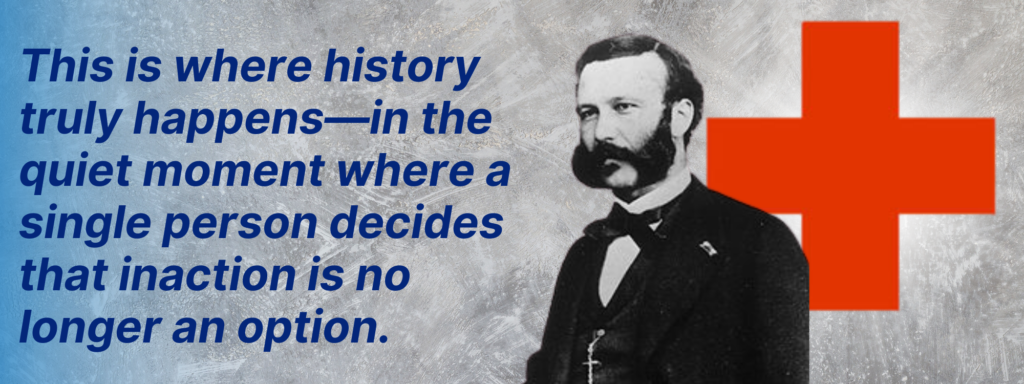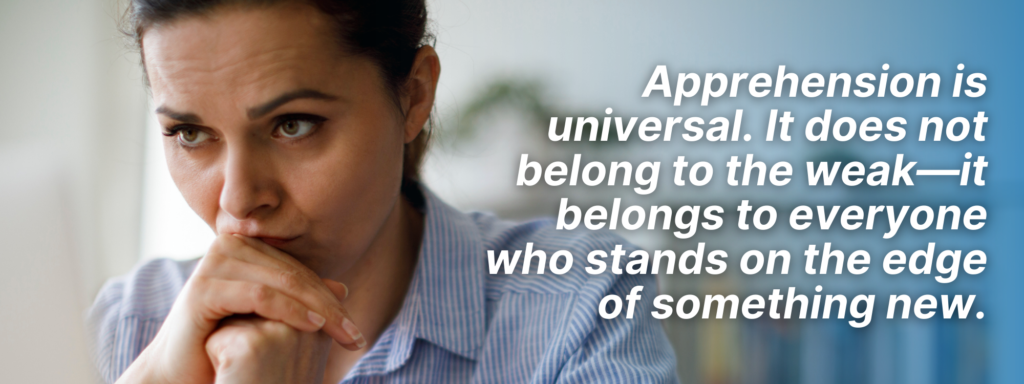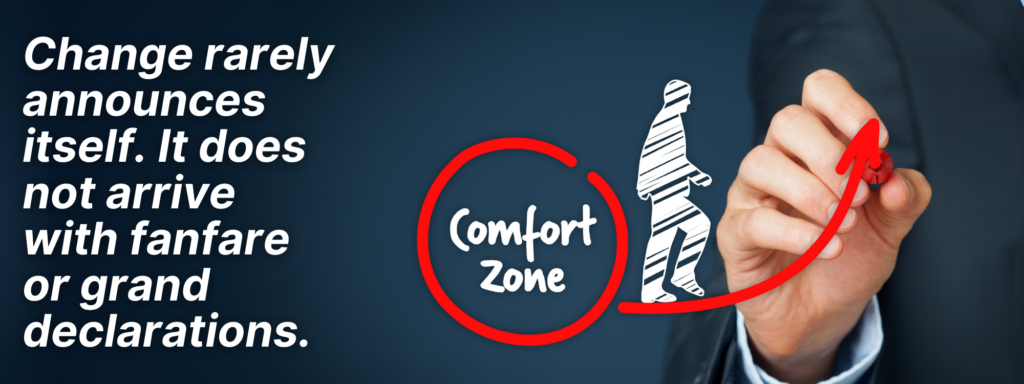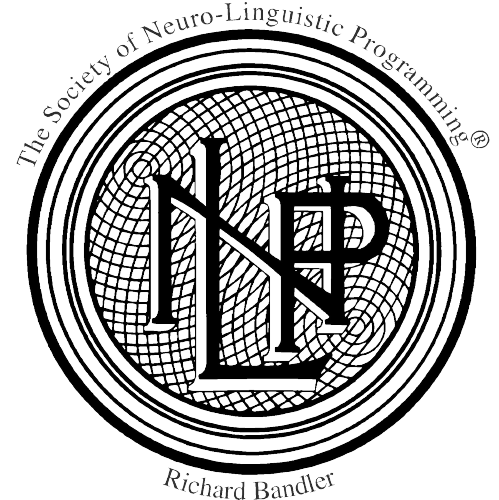Primed for Flame
There is always a moment before change—an apprehension, a pause where everything holds its breath. It is the second before the footsteps forward, before the brush touches canvas, before the words are spoken. The moment when doubt is loudest.
If you have ever felt that apprehension, you are not alone. It is universal. Before every great movement, before every breakthrough, there is this moment of stillness—a moment that could pass unnoticed, that could slip away and leave the world unchanged. History does not record these moments, but they are where everything begins.
We celebrate revolutions and tipping points, the grand moments when the world shifts. But what about the second before? The second when uncertainty, fear, and self-doubt weigh heaviest? Because that is where the real story begins—not with the explosion, but with the flicker of apprehension that precedes it.

The Choice to Act
Imagine a battlefield in 1859, just outside the Italian town of Solferino. The air is thick with the iron tang of blood, the groans of the dying rising into the heat of the afternoon. Thousands of wounded soldiers lie abandoned, left to die because no system exists to help them.
A Swiss businessman, Henry Dunant, stands among the carnage. He is not a general, not a doctor, not a statesman. He has no obligation to be here, no official role. He is just a man, standing in front of suffering, knowing he cannot look away.
But what can he do? He has no army, no resources, no authority to command action. He could tell himself that this is the way of things, that war has always been this way, that it is not his place to interfere. And for a moment, he hesitates.
The moment could have passed. He could have turned away, convinced himself it was not his responsibility. The world would have remained unchanged. But instead of walking away, he moves.
He gathers civilians, organises care, and sets in motion an idea that will become the International Red Cross. But that future was not guaranteed. It hinged entirely on a single decision: whether to step into the unknown or retreat into safety.
This is where history truly happens—not in the aftermath, not in the retelling, but in the quiet moment where a single person decides that inaction is no longer an option.
The Choice to Stay
Most of us will never stand on battlefields, but we will all face moments like this. The tension before action. The quiet before disruption. The moment before the first step is taken. Change is never inevitable—it is always optional.
The same apprehension gripped four young Black students in a North Carolina diner in 1960. They sat down at a segregated lunch counter, knowing full well they would not be served. The rules were clear: they would be ignored, they would be asked to leave, and if they did not, they could be arrested. Their hearts pounded, not with certainty, but with fear.
They were not heroes, not yet. They were four young men waiting for something to happen—waiting to see if their act of defiance would hold.
In another universe, maybe they stood up and left. Maybe they convinced themselves that nothing would change. Maybe they walked back to campus, shaking their heads at their own foolishness. But instead, they stayed.
And in staying, they ignited something that spread across the country. What was once a single, hesitant decision became a movement. Within weeks, sit-ins had spread across the South, forcing businesses, cities, and lawmakers to confront segregation.
This is the pattern. A world that seems immovable. A moment of uncertainty and fear. And then, one person, an ordinary person, chooses to act. Everything after that is history.

The Choice to Move
The greatest lie about change is that the people who create it are fearless. That they wake up certain, that they know exactly what they are doing, that they are immune to doubt.
They are not.
Fear is always there, waiting at the threshold. It is in the scientist staring at a petri dish, wondering if what she sees is real or just another failure. It is in the artist, rejected by every major gallery, wondering if he should abandon his vision or paint just one more canvas. It is in the protester’s clenched fists, in the young entrepreneur staring at a blank business plan, in the runner at the starting line of the first modern Olympic marathon, wondering if anyone will care.
The question is never “Am I afraid?”. The question is “Will I move despite it?”
Because apprehension is universal. It does not belong to the weak—it belongs to everyone who stands on the edge of something new.
The Pause Before the Breakthrough
Take Alexander Fleming, hunched over a cluttered desk in 1928, staring at an abandoned petri dish. Something strange had happened—a fungus was killing the bacteria around it. It was interesting, sure, but was it important? He hesitated. If he let it go, nothing would change. If he pursued it, he might be wasting time chasing a dead end.
For ten years, nothing happened. No great discovery, no medical revolution. Penicillin sat unnoticed. But the discovery was still there, waiting. Waiting for someone else to see it.
That someone was Howard Florey and Ernst Chain, who recognised the significance of Fleming’s abandoned research and pushed it forward. Their decision led to the first mass-produced antibiotic—an innovation that would save hundreds of millions of lives.
And yet, it could have been lost forever in apprehension. The world is full of unfinished discoveries, of ideas abandoned in doubt, of movements that never began because someone decided to wait instead of act.
Claude Monet knew that apprehension. He and a group of radical painters had been laughed out of the French art establishment—too chaotic, too unfinished, too strange. For years, they were dismissed, their work rejected from every prestigious gallery. It would have been easier to abandon their vision, to conform to the rules of traditional painting. Instead, they moved forward when others hesitated.
They held their own exhibitions, defiantly calling themselves “Impressionists”: a name given to them as an insult. And in doing so, they reshaped the very definition of art. Change does not begin with the confident. It begins with those who are uncertain but refuse to let uncertainty make their decisions for them.
And so, history turns. A scientist studies an abandoned experiment. A young painter refuses to conform. A group of students stays seated at a lunch counter when the world tells them to leave. All of them, in the same moment of apprehension, asking the same question:
Do I act, or do I let this moment pass?
This is what separates those who observe change from those who create it. Not talent. Not status. Not genius. A single choice. And anyone can make it.
From One to Everyone
At first, it seems like nothing has changed. The scientist walks home after a long day in the lab, still uncertain whether the experiment is worth pursuing. The artist finishes another painting that no gallery will accept. The students leave the lunch counter, hearts pounding, unsure if anyone noticed their quiet defiance. And yet, something has shifted.
The world is slow to recognise change while it is still small, but change is never a solitary act. The moment one person moves, others begin to feel the possibility of movement too. Apprehension, after all, is not just an individual experience—it is collective.
The same doubts that ran through the mind of a single protester sitting at a lunch counter existed in the minds of thousands of others, waiting for a signal. One person’s courage becomes a permission slip for others.
Benjamin Franklin understood this when he founded the first volunteer fire brigade in 1736. At the time, fires were seen as individual tragedies, not communal responsibilities. There were no professional fire services, no coordinated responses. If your house caught fire, you were on your own. The system was not built to change.
Franklin’s brigade was small, informal—a group of people willing to act rather than assume someone else would. There was no law compelling them, no government decree forcing a shift. It was just a handful of people deciding to act despite uncertainty. But here is the thing about action: it catches on.
Soon, other cities formed their own brigades. The idea spread, gathering momentum, reshaping how communities responded to crisis. Today, the idea that fire services are a universal public good is so deeply embedded in society that we forget how radical it once was. And yet, it all began in apprehension. In a single person wondering if anyone would follow.
This is the pattern that repeats across time. The first step is always taken in isolation. But the second? The third? The hundredth? Those steps belong to others.
The Marathon That Shouldn’t Have Been
When the first modern Olympic marathon was introduced in 1896, it was not considered a serious athletic event. It was a novelty, an experiment, an echo of an ancient legend. The idea that people could or should run 26.2 miles competitively seemed absurd. There was no global infrastructure, no professional marathon runners. And yet, someone ran.
And because someone ran, someone else saw that it could be done. And because enough people saw, the race was held again. The distances were formalised. The rules were refined. What had once been an obscure experiment became one of the most prestigious sporting events in the world.

A Very Human Pattern
This is how change happens—not through the overwhelming force of a single hero, but through the quiet, cumulative courage of many. Claude Monet was not the only Impressionist. Alexander Fleming did not mass-produce penicillin alone. The Civil Rights Sit-Ins did not end segregation in a single act of defiance. But someone had to go first.
That is the difference. Not status, not talent, not genius. Just the willingness to break the illusion of inaction. Because once people see that movement is possible, they begin to move too.
Change rarely announces itself. It does not arrive with fanfare or grand declarations. Instead, it spreads silently, like embers catching in dry grass. What begins as a single moment of defiance, of creativity, of curiosity does not stay contained—it radiates outward. The history of progress is not a history of grand revolutions. It is a history of small decisions, unnoticed at first, waiting for the right moment to ignite.
In 1954, Dr Joseph Murray performed the world’s first successful kidney transplant. It was a medical breakthrough—but at the time, it was also controversial, untested, uncertain. The idea of transplanting organs seemed unnatural, even dangerous. Many hesitated.
The procedure worked. And suddenly, what was once impossible became possible. The landscape shifted. New techniques were developed. Ethical concerns were debated, then resolved. Today, organ transplantation is not just accepted—it is a global medical standard. But imagine if that first move had never been made. Imagine if the apprehension had won. Once the first step is taken, the impossible begins to look inevitable.
The same happened with the rise of K-pop. In the 1990s, South Korea’s music industry was a regional curiosity, ignored by the Western world. American and British artists dominated the charts. The idea that Korean pop music could become a global industry was, at best, wishful thinking. And yet, behind the scenes, something was shifting.
Artists, producers, and visionaries refused to conform to expectations. They honed their craft, built new industry structures, and persisted through decades of scepticism. They were ridiculed. They were dismissed. But they moved anyway. And then, slowly, the world started noticing.
What had once been a niche movement became an international force. Today, K-pop fills stadiums across Europe, North America, and beyond. It dominates streaming platforms. It has redefined the global music industry. And it only exists because, at some point, someone decided to move forward despite the doubts.
Because this is the human pattern. First, apprehension—the belief that nothing can change. Then, the first step—often unnoticed, often lonely. Then, the spread—the moment when others see and begin to act. Finally, the shift—the point where the once-unthinkable becomes reality.
Not just in science. Not just in art. Everywhere. Scientific discoveries. Artistic revolutions. Political movements. Medical breakthroughs. Cultural shifts. They all follow this same pattern. And here is why that matters: if this pattern holds across history, then it holds for you too.
Change is not waiting for permission. It is not waiting for a leader, a hero, or the perfect moment. It is waiting for someone—anyone—to decide that this moment will not pass in silence.
It is waiting for someone to take the first step. And the only question left is:
Who will move next?
A Final Reflection
The world does not change all at once. There is no single moment when everything is different, no great switch flipped that makes the old world fall away and the new one take its place. Change moves like fire in dry grass—slow at first, barely visible, then, all at once, unstoppable. And yet, it does not begin with the flames. It begins with the spark.
- A doctor, standing over an experimental procedure, uncertain if the world will accept what he has just done.
- A painter, rejected by every major gallery, refusing to soften his vision
- A scientist, staring at a petri dish, wondering if this strange growth is worth investigating
- A group of students, palms sweating, sitting at a lunch counter where they are not welcome.
In that moment—before the movement, before the revolution, before the discovery—there is only apprehension.
And yet, one step forward changes everything. Not because history belongs to the powerful, the wealthy, the connected. But because history belongs to those who do not let their apprehension make their decisions for them.
This pattern is deeply human. It has repeated across time, across disciplines, across cultures. The first fire brigades, the first medical breakthroughs, the first daring redefinitions of music, of art, of sport—they all begin the same way.
- With uncertainty.
- With apprehension.
- With a choice.
And if that is true—if every moment of transformation in history began with someone standing where you stand now, in apprehension—then what does that tell us?
It tells us that change is not something other people do. It is not the domain of geniuses, revolutionaries, or the extraordinarily brave. It is the natural result of choosing movement over stagnation. It tells us that anyone can make history—not in the grand, cinematic way we imagine, but in the way that history has always been made:
In a moment of doubt, met with a moment of defiance.
A Final Question
The first steps are always small. The first fires are always fragile. The first movements always begin with a single person who could have stayed silent, who could have walked away—but didn’t.
And so the question remains. The apprehension will come. The doubt will whisper. The fear will always be there. But when the moment arrives, and the choice is in your hands, what will you do? Will you stay where you are?
Or will you move?



